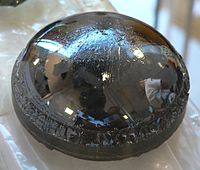
Photo from wikipedia
Abstract Conductive polymer composite (CPC) materials are extensively used for the bipolar plate in Polymer Electrolyte Membrane Fuel Cells (PEMFCs). The produced CPC materials through the extrusion process strongly relate… Click to show full abstract
Abstract Conductive polymer composite (CPC) materials are extensively used for the bipolar plate in Polymer Electrolyte Membrane Fuel Cells (PEMFCs). The produced CPC materials through the extrusion process strongly relate to electrical conductivity and mechanical properties. In this study, milled carbon fibre (MCF) reinforced polypropylene (PP) incorporating carbon nanotube (CNT), or graphene nanoplatelets (xGNP) are pre-mixed using the extrusion process to orientate the fibres before undergoing the compression moulding at 13.8 MPa and 200 °C for 15 min. The CNT composites exhibited the higher through-plane conductivity of 14.8 S/cm as compared to xGnP composites with 4.9 S/cm at 70 wt% of MCF. The flexural strength improved after being compressed to 99.6 MPa and 172.5 MPa for 70 wt% of CNT and xGNP, respectively. This reveals that the oriented fibres can boost the CPC performance.
Journal Title: International Journal of Hydrogen Energy
Year Published: 2019
Link to full text (if available)
Share on Social Media: Sign Up to like & get
recommendations!